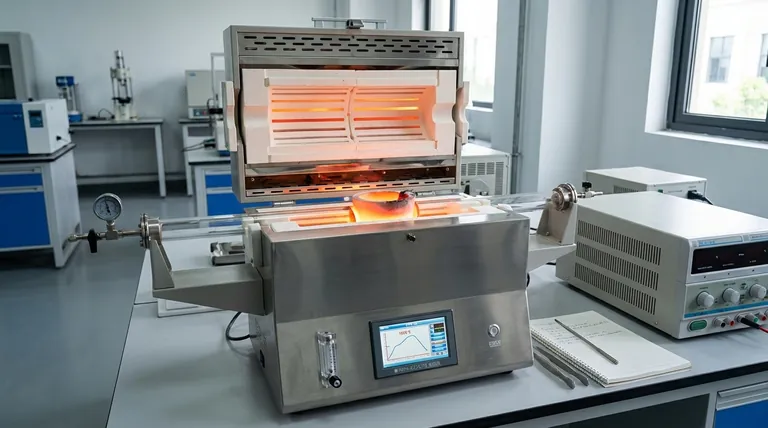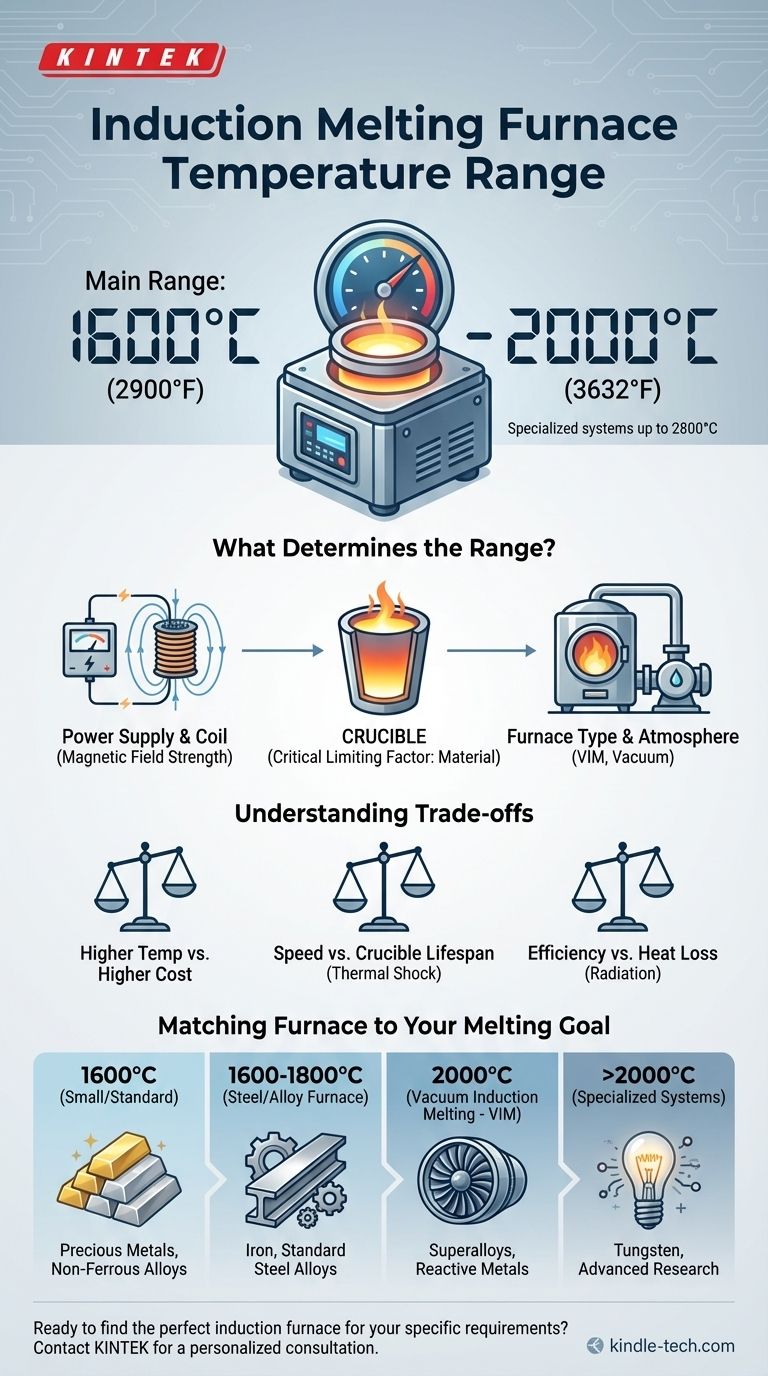The temperature range of an induction melting furnace is broad, but most commercial models operate at maximum temperatures between 1600°C (2900°F) and 2000°C (3632°F). While some highly specialized systems can exceed this and reach up to 2800°C, the practical limit for a given furnace is determined by its design, power supply, and most critically, the material of the crucible holding the metal.
The maximum temperature of an induction furnace is less about the heating technology itself and more about the physical limits of the container holding the molten metal. The furnace's type—be it a small tabletop unit or a large vacuum furnace—and its crucible define its operational ceiling.

What Determines the Furnace's Maximum Temperature?
Understanding the components that dictate the temperature range is key to selecting the right equipment. The final temperature is not an arbitrary number but a result of a system's design limitations.
The Role of the Power Supply and Coil
An induction furnace works by using a powerful, high-frequency power supply (often using IGBT technology) to drive an electric current through a copper coil.
This coil generates a strong, rapidly alternating magnetic field. When a conductive material like metal is placed within this field, the field induces powerful eddy currents within the metal, causing it to heat up and melt rapidly through resistive heating.
A more powerful supply can generate a stronger magnetic field, enabling a faster temperature rise and a higher potential peak temperature.
The Critical Limiting Factor: The Crucible
The true bottleneck for temperature is the crucible. This is the refractory ceramic or graphite container that holds the metal charge as it melts.
The crucible must be able to withstand the extreme temperature of the molten metal without melting, cracking, or reacting with the charge. The material of the crucible sets the practical temperature limit for the entire system.
For example, a clay-graphite crucible may be suitable for lower-temperature metals like aluminum or gold, while a furnace designed for steel or platinum would require a crucible made of more advanced refractory materials like magnesia or zirconia.
Furnace Type and Atmosphere Control
The furnace's overall design also plays a crucial role.
A small induction furnace is excellent for melting precious metals and can typically reach up to 1600°C. These are valued for their speed and compact size.
A vacuum induction melting (VIM) furnace can achieve higher temperatures, often up to 2000°C. By operating in a vacuum, it removes oxygen and other atmospheric gases, preventing oxidation and allowing for the melting of reactive metals and the production of high-purity superalloys.
Understanding the Trade-offs
Achieving higher temperatures is not just a matter of turning up the power. It involves significant engineering and cost considerations.
Higher Temperature vs. Higher Cost
Reaching extreme temperatures requires a more powerful and sophisticated power supply. More importantly, it demands more advanced and expensive crucible materials that can withstand the heat. A system designed for 2000°C is fundamentally more complex and costly than one designed for 1500°C.
Speed vs. Crucible Lifespan
One of the main advantages of induction melting is its speed. However, extremely rapid heating and cooling cycles create thermal shock, which can significantly reduce the lifespan of the crucible. Operators must balance the need for high throughput against the recurring cost of replacing crucibles.
Efficiency vs. Heat Loss
Induction heating is inherently efficient because it heats the metal directly. However, as the temperature of the molten metal increases, so does the amount of energy lost to the environment through thermal radiation. Maintaining very high temperatures requires a continuous and significant power input to offset these losses.
Matching the Furnace to Your Melting Goal
Choosing the right furnace means aligning its capabilities with the specific requirements of the metals you intend to melt.
- If your primary focus is precious metals (gold, silver) or non-ferrous alloys (copper, aluminum): A standard small or medium furnace with a maximum temperature of 1600°C is more than sufficient and cost-effective.
- If your primary focus is iron and standard steel alloys: You will need a robust furnace capable of reliably reaching and holding temperatures in the 1600°C to 1800°C range.
- If your primary focus is high-purity specialty alloys or reactive metals: A vacuum induction furnace (VIM) capable of reaching 2000°C is essential to control the atmosphere and prevent contamination.
- If your primary focus is refractory metals (e.g., tungsten) or advanced research: You will require a highly specialized system designed for extreme temperatures, potentially exceeding 2000°C.
Ultimately, selecting the correct induction furnace is a deliberate process of matching the equipment's thermal capacity to your specific material and process demands.
Summary Table:
| Furnace Type | Typical Max Temperature | Ideal For Metals Like |
|---|---|---|
| Small/Standard Furnace | Up to 1600°C | Gold, Silver, Aluminum, Copper |
| Steel/Alloy Furnace | 1600°C - 1800°C | Iron, Standard Steel Alloys |
| Vacuum Induction Melting (VIM) | Up to 2000°C+ | Superalloys, Reactive Metals |
| Specialized Systems | Exceeds 2000°C | Tungsten, Advanced Research |
Ready to find the perfect induction furnace for your specific metal and temperature requirements?
At KINTEK, we specialize in providing high-performance lab equipment, including induction melting furnaces tailored for everything from precious metals to advanced alloys. Our experts will help you select a system that delivers the precise temperature control, efficiency, and reliability your laboratory needs.
Contact our team today for a personalized consultation and discover the KINTEK advantage in laboratory melting solutions!
Visual Guide

Related Products
- 1400℃ Laboratory Quartz Tube Furnace with Alumina Tube Tubular Furnace
- 1700℃ Laboratory Quartz Tube Furnace with Alumina Tube Tubular Furnace
- Laboratory Muffle Oven Furnace Bottom Lifting Muffle Furnace
- 1800℃ Muffle Oven Furnace for Laboratory
- High Temperature Muffle Oven Furnace for Laboratory Debinding and Pre Sintering
People Also Ask
- What is the high temperature of a tube furnace? Unlock the Right Model for Your Application
- What is a tubular furnace used for? Precision Heating for Material Synthesis & Analysis
- What are the advantages of a tube furnace? Achieve Superior Temperature Uniformity and Control
- How does a tubular furnace work? A Guide to Controlled High-Temperature Processing
- What materials are used for the tubes in tube furnaces? A Guide to Selecting the Right Tube for Your Process



















